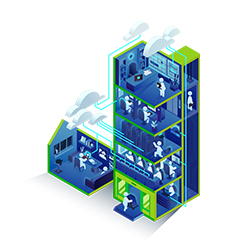Author: Angad Soni
Chief Architect, Business Applications & Data Modernization
Long View
Introduction:
Welcome to a world where the integration of human potential and artificial intelligence blend together seamlessly across the enterprise. As we envision a future empowered by co-pilots, it is crucial to ensure that the steps we take today are practical and realistic in response to the groundbreaking and transformative technology like co-pilots. This blog presents five actionable steps that enable us to embrace the co-pilot future allowing us to navigate the present while paving the way for a remarkable future.
Embrace the Brilliance of Data and AI:
- Harness the power of data and AI today to drive insights and enable informed decision-making.
- Leverage AI technologies to optimize workflows, streamline processes, and augment human capabilities.
Cultivate Ethical Boundaries:
- Prioritize ethical considerations in all aspects of AI development and deployment.
- Ensure transparency, fairness, and accountability in the design and implementation of AI systems.
Collaboration between Humans and Co-Pilots:
- Foster collaboration and synergy between humans and co-pilots.
- Embrace co-pilots as tools to amplify human intelligence and achieve greater collective outcomes.
Design with Human-Centered Radiance:
- Place humans at the center of co-pilot development and implementation.
- Create co-pilots that enhance user experiences, respect privacy, and address human needs.
Empower Individuals with Radiant Co-Pilot Education:
- Promote co-pilot literacy and provide education and training opportunities for individuals.
- Equip individuals with the knowledge and skills to effectively utilize and interact with co-pilots.
Enabling a co-pilot future starts with taking action today. By embracing the intelligence of data and AI, cultivating ethical boundaries, collaboration, designing with human-centered training, and empowering individuals, we can set the stage for a future where co-pilots enhance our daily day-to-day. Take these steps today, and together, let us enable a co-pilot future that agreeably merges technology and people.
These are just a few examples of how Copilot can be used across different industries.
Education: Copilot can be used to create interactive learning materials, automate grading systems, and provide personalized learning experiences. It can also assist in administrative tasks such as scheduling, student data management, and communication with parents.
Healthcare: In the healthcare industry, Copilot can assist in patient data management, appointment scheduling, and even provide health advice based on medical guidelines. It can also be used for research purposes, such as analyzing medical data and predicting health trends.
Retail: Copilot can analyze sales data to predict future trends and inventory needs. It can also assist in customer service by handling inquiries and providing product information.
Finance: In the finance sector, Copilot can be used for risk assessment, financial forecasting, and data analysis. It can also assist in automating routine tasks such as invoice processing and expense management.
Customer Service: Copilot can develop AI-powered chatbots to handle customer inquiries. These chatbots can answer FAQs, provide product information, and even escalate complex issues to human representatives.
Marketing: Copilot assists in generating ideas, crafting copy, creating reports, and optimizing campaigns. It can also analyze marketing data to provide insights and recommendations.
Human Resources: In HR, Copilot can assist in resume screening, scheduling interviews, and employee data management. It can also provide insights for performance reviews and workforce planning.
Project Management: Copilot aids in planning, executing, and monitoring projects. It can automate task assignment, track project progress, and provide predictive insights for project risks and opportunities.
Sales: Copilot helps generate leads, create proposals, write sales emails, and analyze data. It can also provide predictive insights for sales trends and customer behavior.

Subscribe to our newsletter for the latest updates.